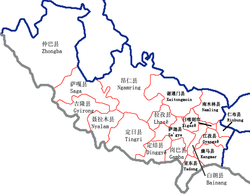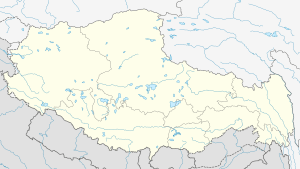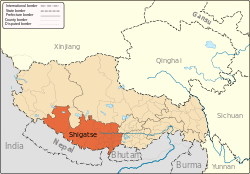Ngamring County
| Ngamring County 昂仁县 • ངམ་རིང་རྫོང་། | |
|---|---|
| County | |
 | |
.png) Location of Ngamring County (red) within Xigazê City (yellow) and Tibet | |
 Ngamring Location of the seat in Tibet | |
| Coordinates: 29°16′22″N 87°10′57″E / 29.27278°N 87.18250°ECoordinates: 29°16′22″N 87°10′57″E / 29.27278°N 87.18250°E | |
| Country | People's Republic of China |
| Autonomous region | Tibet |
| Prefecture-level city | Xigazê |
| Seat | Kagar |
| Time zone | UTC+8 (China Standard) |
Ngamring County (Tibetan: ངམ་རིང་རྫོང་།, Wylie: ngam ring rdzong, ZYPY: Ngamring Zong ; Chinese: 昂仁县; pinyin: Ángrén Xiàn) is a county of Xigazê in the Tibet Autonomous Region. "Ngamring County, sometimes referred to as the gateway to Mount Kailash and Far West Tibet, is the barren area which divides the Raga Tsangpo and the Brahmaputra."[1]
The office place of the county is located in Kagar (卡嘎), population 1,700, at an elevation of 4,380 m (14,370 ft).[2]
Towns and townships
- Gegang Town (གད་སྒང་, 卡嘎镇)
- Sangsang Town (བཟང་བཟང་, 桑桑镇)
- Yagmo Township (ཡག་མོ་, 亚木乡)
- Dagyu Township (རྟ་རྒྱུད་, 达居乡)
- Qu'og Township (ཆུ་འོག་, 秋窝乡)
- Kairag Township (གད་རགས་, 切热乡)
- Dobê Township (མདོ་སྤེ་, 多白乡)
- Riwoqê Township (རི་བོ་ཆེ་, 日吾其乡)
- Xungba Township (གཞུང་བ་, 雄巴乡)
- Cazê Township (ཚྭ་རྩེ་, 查孜乡)
- Amxung Township (ཨམ་གཞུང་, 阿木雄乡)
- Rusar Township (རུ་གསར་, 如沙乡)
- Kunglung Township (གུང་ལུང་, 孔隆乡)
- Nyigo Township (ཉི་སྒོ་, 尼果乡)
- Comë Township (ཚོ་སྨད་, 措迈乡)
- Darog Township (རྟ་རོག་, 达若乡)
- Goin'gyibug Township (དགོན་སྐྱིད་སྦུག་, 贡久布乡)
Landmarks and monasteries
The Chung Riwoche Stupa is located on the north bank of the Brahmaputra. "A narrow iron bridge spans the river here, alongside an original iron-chain footbridge attributed to Tangtong Gyelpo,"[1] the founder of Tibetan opera, who was born in Ngamring County. "Legend has it that the iron chain bridge over the Xiongqoi River ... was built with funds collected by Tongdong Gyaibo through performances."[3][4]
Another point of interest is the Ralung Chutse hot spring, which has camping and a guest house.[1]
Zangzang Lhadrak Cave in Ngamring County was where Padmasambhava hid the "Northern Treasures," which consisted of "a number of texts and various sacred objects in a maroon leather casket." These texts and objects were removed in 1366 by Vidyadhara Gödem, and became known as the Dzö Nga (mdzod lnga) or Five Treasuries. The "Northern Treasures" were taught at the Dorje Drak Monastery, and include the Künzang Gongpa Zangtha teachings, a collection of Dzogchen instructions.[5]
Ngamring Monastery[6] or Ngamring Chöde (Wylie: ngam ring chos sde[7] ) produced many important scholars.[8] It was founded in 1225 as a Sakya monastery when "the Ngamring ruler Drakpa Dar (Grags pa dar), also known as Yöntsun (Yon btsun), invited the Sakya master Shākya Sengé (Shākya seng ge) to Ngamring and founded the monastery there."[9]
It was later expanded by the governor Tai En Namkha Tenpa (Ta'i dben Nam mkha' brtan pa, b. 1316) with the assistance of his teacher, the Omniscient Dolpopa Sherab Gyaltsen (Dol po pa Shes rab rgyal mtshan, 1292-1361).[9]
The monastery also followed the Jonang and Bodongpa traditions. It became a Gelugpa monastery at the time of the 5th Dalai Lama. "Tangtong Gyalpo's teacher Ka Ngapa Paljor Sherab (Bka' lnga pa Dpal 'byor shes rab) was the ninth abbot."[9]
Transport
See also
- Thang Tong Gyalpo (1385–1464 or 1361–1485), builder of iron bridges and father of Tibetan opera
References
- 1 2 3 "Ngamring County". TibetMaster. Retrieved 2013-10-20.
- ↑ Map of locations in Namling County, China Tibet Information Center
- ↑ "Xigaze". China Tibet Information Center. Retrieved 2013-10-19.
- ↑ Stearns, Cyrus; Gyur-med-bde-chen, Lo-chen (2007). King of the empty plain: the Tibetan iron-bridge builder Tangtong Gyalpo. Tsadra Foundation series. Ithaca, N.Y: Snow Lion Publications. ISBN 9781559392754.
- ↑ "History of the Künzang Gongpa Zangthal Transmissions". Mindrolling International. 2010-04-26. Archived from the original on 2013-10-20. Retrieved 2013-10-20.
- ↑ pinyin: Angren si
- ↑ pinyin: Angren Qude si Gelu pai simiao - Angren Quede si I, II
- ↑ For information about the debate between Bodong Chögle Namgyel (Bo dong Phyogs las rnam rgyal; 1376-1451) of the Bodong school and the Sakya scholar Khedrub Je Geleg Pelsang (mkhas grub rje dge legs dpal bzang; 1358-1438), see: Monika Schrempf (editor): Soundings in Tibetan medicine (Leiden 2007) and Bstan-'dzin-rgya-mtsho (Dalai Lama XIV), Jeffrey Hopkins: Kālachakra tantra: rite of initiation : for the stage of generation (1999).
- 1 2 3 Chakzampa Thangtong Gyalpo Chakzampa Thangtong Gyalpo: Architect, Philosopher and Iron Chain Bridge Builder. Manfred Gerner. Translated by Gregor Verhufen. (2007). Center for Bhutan Studies. ISBN 99936-14-39-4.
External links
- Map of locations in Namling County, China Tibet Information Center
